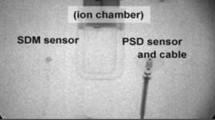Abstract
Background
Interventional procedures frequently employ fluoroscopy or digital subtraction angiography (DSA). Few studies have documented radiation doses received by children during these procedures.
Objective
To measure skin entrance dose received during common pediatric interventional procedures.
Materials and methods
MOSFET dosimeters were placed to record skin doses in 143 children undergoing any of five procedures: 30 PICC insertions, 34 CVL/port insertions, 30 G/GJ tube insertions, 25 sclerotherapy/vascular anomaly procedures, 24 cerebral angiography procedures. The highest recorded dose (HRD) from the five MOSFET probes was assumed to be the peak skin dose per child. HRD values were averaged for children within each group and correlated with patient weight, fluoroscopy time and number of DSA frames.
Results
Average HRD was 1.8 mGy for PICC insertions, 1.4 mGy for CVL/port insertions, 3.9 mGy for G/GJ tube insertions, 39.1 mGy for sclerotherapy/vascular anomaly procedures, and 149.9 and 101.6 mGy for frontal and lateral portions of cerebral angiography procedures. These entrance doses corresponded to effective dose estimates in the range 0.4–3 mSv. There were only modest correlations between peak skin dose and fluoroscopy time, patient weight and DSA frames (r 2<0.4, P < 0.01).
Conclusion
Pediatric interventional procedures are associated with a wide range of doses; those at the higher end require careful monitoring.



Similar content being viewed by others
References
International Commission on Radiological Protection (2001) Avoidance of radiation injuries from medical interventional procedures, CRP publication 85. Elsevier, Philadelphia
Suleiman O (2004) Radiation doses in pediatric radiology: influence of regulations and standards. Pediatr Radiol 34:242–246
US Food and Drug Administration (1995) Clarification: recording information in the medical patient’s record that identifies the potential for serious X-ray induced skin injuries. Center for Devices and Radiological Health, Rockville, MD
Geise RA, Eubig C, Franz S et al (1998) AAPM report no. 58. Managing the use of fluoroscopy in medical institutions. Medical Physics Publishing, Madison, WI
Geise R, O’Dea T (1999) Radiation dose in interventional fluoroscopic procedures. Appl Radiat Isot 50:173–184
Vano E, Gonzalez L, Ten J et al (2001) Skin dose and dose-area product values for interventional cardiology procedures. Br J Radiol 74:48–55
Gkanatsios N, Huda W, Peters K (2001) Adult patient doses in interventional neuroradiology. Med Phys 29:717–723
Kemerink G, Frantzen M, Oei K et al (2002) Patient and occupational dose in neurointerventional procedures. Neuroradiology 44:522–528
Miller D, Balter S, Cole P et al (2003) Radiation doses in interventional radiology procedures: the RAD-IR study. J Vasc Interv Radiol 14:711–727
Brenner D, Elliston C, Hall E, Berdon W (2001) Estimated risks of radiation-induced fatal cancer from pediatric CT. AJR 176:289–296
Frush D, Donnelly L, Rosen N (2003) Computed tomography and radiation risks: what pediatric health care providers should know. Pediatrics 112:951–957
Balter S, Fletcher D, Kuan H et al (2002) Techniques to estimate radiation dose to skin during fluoroscopically guided procedures. AAPM, Medical Physics Publishing, Madison, WI
Swoboda N, Armstrong D, Charkot E et al (2005) Pediatric patient surface doses in neuroangiography. Pediatr Radiol 35:859–866
Best Medical Canada (2008) Thomson Nielsen mobile MOSFET operator’s manual. Best Medical Canada, Ottawa, Canada
Yoshizumi TT, Goodman PC, Frush DP et al (2007) Validation of metal oxide semiconductor field effect transistor technology for organ dose assessment during CT: comparison with thermoluminescent dosimetry. AJR 188:1332–1336
Yoshizumi T, Sarder M, Goodman P et al (2003) Application of MOSFET technology in CT organ assessment (abstract). Proceedings AAPM Annual Meeting. Med Physics 30:1422
McClave J, Dietrich F (1988) Statistics, 4th edn. Dellen, San Francisco
Hart D, Jones DG, Wall BF (1996) Estimation of effective doses for pediatric X-ray examinations. NRPB-R279. National Radiation Protection Board, Chilton
National Research Council (1990) Health effects of exposure to low levels of ionizing radiation. BEIR V. National Academy Press, Washington DC
Hall EJ (2002) Lessons we have learned from our children: cancer risks from diagnostic radiology. Pediatr Radiol 32:700–706
van de Putte S, Verhaegen F, Taeymans Y et al (2000) Correlation of patient skin doses in cardiac interventional radiology with dose-area product. Br J Radiol 73:504–513
Chu RY, Thomas G, Maqbool F (2006) Skin entrance radiation dose in an interventional radiology procedure. Health Phys 91:41–46
Roshau J, Hintenlang D (2003) Characterization of the angular response of an isotropic MOSFET dosimeter. Health Phys 84:376–379
Author information
Authors and Affiliations
Corresponding author
Rights and permissions
About this article
Cite this article
Glennie, D., Connolly, B.L. & Gordon, C. Entrance skin dose measured with MOSFETs in children undergoing interventional radiology procedures. Pediatr Radiol 38, 1180–1187 (2008). https://doi.org/10.1007/s00247-008-0966-y
Received:
Revised:
Accepted:
Published:
Issue Date:
DOI: https://doi.org/10.1007/s00247-008-0966-y




